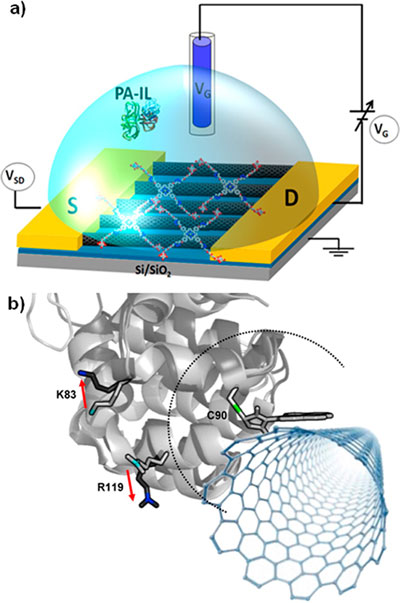| Sep 16, 2013 |
Label-free detection of biomarkers with carbon nanotubes
|
|
(Nanowerk News) Carbon nanotubes (CNTs) have been of high interest because of their potential to complement or to replace current biomedical sensor and assay techniques. By taking advantage of their unique electrical and optical properties, CNTs can be integrated into highly sensitive sensors and probes.
|
|
A new Perspective article in the September 13, 2013 online edition of ACS Nano ("Carbon Nanotubes for the Label-Free Detection of Biomarkers") highlights recent advances toward applying CNTs to the biomedical field.
|
 |
| a) Schematic illustration of single-walled carbon nanotube (SWNT) field-effect transistor device functionalized with glycosylated porphyrins for selective detection of bacterial lectins (PA-IL). Aligned SWNTs connect source and drain electrodes, and a Ag/AgCl reference electrode directly immersed in the buffer solution gates the transistor. b) Depiction of a single lysozyme attached to a SWNT via a maleimide-pyrene linker. The catalytic activity of the enzyme can be probed due to the motion of the charges at residues 83 and 119. (© American Chemical Society)
|
|
The authors, led by Alexander Star, show that the inherent electronic, structural, and optical properties of carbon nanotubes offer the potential to create advanced biophysical tools that can compete with existing biomedical techniques and review recent research toward this goal. They report that carbon nanotubes are on their way to being established as a versatile component in next-generation biomedical assays.
|
|
"They can be utilized as high-end biophysical tools to reveal subtle dynamics of single biomolecules and can compete with common biological assays. For glycoprofiling, liquid chromatographic techniques (LC, for compound separation) are typically used in combination with mass spectrometry (MS, for detailed structural analyses). However, LC/MS requires relatively large sample volumes, is time-consuming, and glycan liberation from the protein is needed.
|
|
"Other traditional techniques rely on labeling with fluorescently active molecules (ELISA, resazurin-reduction assay), complex and expensive equipment, and are severely limited by photobleaching. In contrast, SWNTs fluoresce in the NIR, are not susceptible to photobleaching, and samples can be analyzed in a matter of minutes. Carbon nanotube array-based platforms could outperform conventional methods in terms of label-free and rapid, online monitoring of biological interactions without suffering from a loss in simplicity and sensitivity.
|
|
"While recent progress toward advancing biomedical techniques with CNTs has been significant, attention still must be paid to several areas. First, electronic sensors built on nanotube structures are highly susceptible to Debye screening, and therefore, the surrounding media and size of functionalization molecules are vitally important. Second, further work must be directed toward adapting these sensors for applications in complex media while retaining selectivity and sensitivity. In contrast, optical arrays have the ability to overcome many of the shortcomings of electronic measurements, and further development of these platforms will facilitate the development of many noninvasive, cost-effective POC techniques that current, standard techniques are unable to address fully."
|

